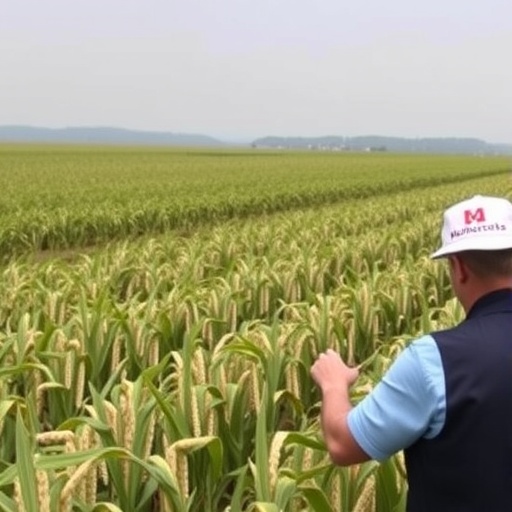China’s Massive US Soybean Purchase Pledge Signals Trade Thaw: Farmers Eye Boom in Exports
In a landmark move that’s sending ripples through global markets, China has agreed to substantial purchases of American Soybeans as part of a broader US-China trade de-escalation framework. This commitment, announced amid ongoing diplomatic efforts, promises to inject new life into the beleaguered US agriculture sector, particularly for soybean farmers who have weathered years of trade uncertainties.
The deal, described by US Treasury Secretary Scott Bessent as a ‘multi-year lifeline’ for American producers, could see China ramping up imports to levels not witnessed since before the trade wars escalated in 2018. With Soybeans at the forefront of this agricultural resurgence, US farmers are poised for what Bessent called an outcome that will leave them ‘extremely happy.’ This development not only alleviates immediate pressures on rural economies but also underscores a potential shift in China trade dynamics, where exports of key commodities like Soybeans could stabilize and grow.
Treasury Secretary Bessent’s Optimistic Outlook for Soybean Farmers
US Treasury Secretary Scott Bessent didn’t mince words when addressing the press on the heels of the agreement. ‘Soybean farmers will be extremely happy with this multi-year agreement,’ he declared, emphasizing the deal’s role in restoring confidence in US agriculture exports. Bessent, who has been instrumental in navigating the complexities of China trade negotiations, highlighted how this commitment aligns with broader efforts to de-escalate tensions that have cost American producers billions.
Under the framework, China has pledged to procure ‘substantial’ volumes of US soybeans over the coming years, with initial estimates suggesting annual purchases could exceed 20 million metric tons— a figure that rivals pre-trade war highs. This isn’t just rhetoric; it’s backed by binding commitments within the trade pact, designed to ensure steady demand for US soybeans, a staple in animal feed and oil production worldwide.
Bessent’s comments come at a time when US farmers have faced volatile markets. Soybean prices have fluctuated wildly, dipping below $10 per bushel in recent years due to reduced Chinese demand. The secretary pointed to data from the US Department of Agriculture (USDA), noting that China accounted for nearly 60% of US soybean exports in 2017, a share that plummeted to under 20% by 2020 amid tariffs and retaliatory measures. ‘This deal reverses that trend,’ Bessent added, ‘putting money back in the pockets of hardworking US farmers.’
Experts echo this sentiment. Dr. Emily Hargrove, an agricultural economist at the University of Illinois, described the announcement as a ‘beacon of hope’ for the sector. ‘For soybeans, this could mean a 15-20% uplift in export revenues within the first year alone,’ she told reporters, citing projections based on historical trade patterns.
Unpacking the Multi-Year Soybean Purchase Agreement
At its core, the agreement outlines a structured increase in China’s imports of US agricultural products, with soybeans taking center stage due to their economic significance. The multi-year nature of the deal—spanning at least five years—ensures predictability, a far cry from the stop-start nature of previous trade talks.
Key details include phased purchase targets: In the first year, China aims to buy at least 15 million metric tons of US soybeans, scaling up to 25 million by year three. These volumes are tied to specific concessions in the trade framework, such as reduced tariffs on US goods and eased restrictions on agricultural biotechnology approvals. The USDA has already begun coordinating with exporters to facilitate these shipments, leveraging ports in the Gulf of Mexico and Pacific Northwest where soybean exports are concentrated.
This isn’t happening in a vacuum. The US soybean industry, valued at over $40 billion annually, supports more than 300,000 jobs across farming, processing, and transportation. Disruptions from China trade spats have led to surplus stockpiles, with US ending stocks reaching record levels of 1.1 billion bushels in 2022. The new deal addresses this by creating a dedicated export corridor, potentially reducing storage costs and boosting farmgate prices.
Furthermore, the agreement incorporates sustainability clauses, requiring US soybeans to meet certain environmental standards—a nod to China’s growing emphasis on green agriculture. This could incentivize US farmers to adopt precision farming techniques, further enhancing the appeal of American exports in the global market.
To illustrate the scale, consider this: A single soybean harvest in the Midwest can yield enough to fill thousands of rail cars bound for China. With this deal, those cars are set to roll again, transforming idle silos into hubs of activity.
Revitalizing US Agriculture Through Renewed China Exports
The impact on US agriculture extends far beyond soybeans, though they remain the linchpin. This trade de-escalation signals a broader thaw in China trade relations, potentially opening doors for other commodities like corn, pork, and cotton. For US farmers, who have endured a rollercoaster of subsidies and market losses, the news is a much-needed win.
Take Iowa, the heartland of American soybean production. The state exported $4.5 billion worth of soybeans to China in 2017, a figure that halved by 2021. Now, with exports poised for recovery, local economies could see a surge in activity. Farmers like Tom Reilly, a third-generation grower from Des Moines, expressed cautious optimism. ‘We’ve planted the same acres year after year, hoping for this day,’ Reilly said in an interview. ‘Stable China trade means we can plan for the future without fear of tariffs wiping out our margins.’
Statistics paint a vivid picture. According to the American Soybean Association, the industry contributes $124 billion to the US GDP and sustains rural communities from Illinois to North Dakota. The trade wars shaved off an estimated $27 billion in lost sales since 2018, prompting many farmers to diversify into alternative crops or even sell land. This deal could stem that tide, with projections from the Farm Bureau estimating a $10 billion annual boost to agriculture exports once fully implemented.
Moreover, the agreement addresses logistical hurdles. Enhanced cooperation on shipping and customs could cut delivery times from US ports to Chinese buyers by up to 30%, making American soybeans more competitive against rivals like Brazil and Argentina, which have filled the gap during US export slumps.
In a surprising angle, this pact also weaves in technology sharing. US firms specializing in GMO soybeans—crucial for high-yield farming—may gain faster regulatory approvals in China, fostering innovation in agriculture and potentially increasing global food security.
Farmers’ Frontline Reactions to the Trade Breakthrough
On the ground, US farmers are buzzing with a mix of relief and excitement. In town halls across the Corn Belt, discussions have shifted from survival strategies to expansion plans. ‘This is the light at the end of the tunnel we’ve been waiting for,’ said Lisa Chenoweth, president of the National Farmers Union, during a virtual panel. She highlighted how the deal directly benefits small and mid-sized operations, which make up 88% of US farms and have been hit hardest by export volatility.
Personal stories underscore the emotional resonance. In Kansas, veteran farmer Miguel Ortiz recounted planting 1,200 acres of soybeans last year only to watch prices tank due to oversupply. ‘My kids are grown, but I want them to come back to the farm someday,’ Ortiz shared. ‘This China trade deal makes that possible again.’ His sentiment is echoed nationwide, with social media lighting up under hashtags like #SoybeanComeback and #FarmersWin.
Industry leaders are equally vocal. The US Grains Council praised the multi-year structure, noting it provides the ‘long-term certainty’ needed for investment in storage and machinery. Meanwhile, export giants like Cargill and Bunge anticipate a hiring spree, with thousands of jobs in processing plants and logistics.
Critics, however, urge caution. Some economists warn that over-reliance on China could expose US agriculture to future geopolitical risks. ‘While this is a step forward, diversification remains key,’ advised Mark Jenkins, a trade policy analyst at the Brookings Institution. Still, the prevailing mood is one of guarded optimism, with farmers gearing up for what could be a banner harvest season.
To delve deeper, consider the ripple effects on related sectors. Soybean meal, a byproduct used in livestock feed, could lower costs for US pork and poultry producers, enhancing their competitiveness in domestic and international markets. This interconnected web of agriculture underscores why the deal is being hailed as a holistic boost for rural America.
Global Trade Horizons: What Lies Ahead for US-China Agriculture Ties
Looking forward, this soybean-centric agreement could herald a new era in US-China trade, with implications stretching from Wall Street to the world’s breadbaskets. Analysts predict it will stabilize commodity prices, potentially easing inflation pressures on food globally as supply chains normalize.
Next steps include bilateral working groups to monitor compliance, with the first review slated for mid-2024. The USDA plans to roll out support programs, including low-interest loans for soybean farmers to modernize equipment and adopt sustainable practices that align with Chinese import standards.
Beyond economics, the deal fosters diplomatic goodwill. By prioritizing agriculture— a sector that employs millions on both sides— it humanizes trade talks, reminding stakeholders of shared interests in food security amid climate challenges.
For US farmers, the horizon is brighter: Increased exports could fund community revitalization, from school upgrades to broadband expansion in rural areas. As Bessent put it, ‘This isn’t just about soybeans; it’s about securing America’s agricultural future in a multipolar world.’
In the long term, experts foresee expanded scopes, possibly including joint ventures in agrotech. If successful, this could position the US as a preferred partner in China’s quest for reliable food imports, driving sustained growth in agriculture exports and fortifying US farmers against future uncertainties.
The path ahead isn’t without challenges— fluctuating currencies, weather risks, and evolving trade policies loom large. Yet, with this de-escalation deal as a foundation, the US soybean sector stands ready to harvest not just crops, but renewed prosperity.








